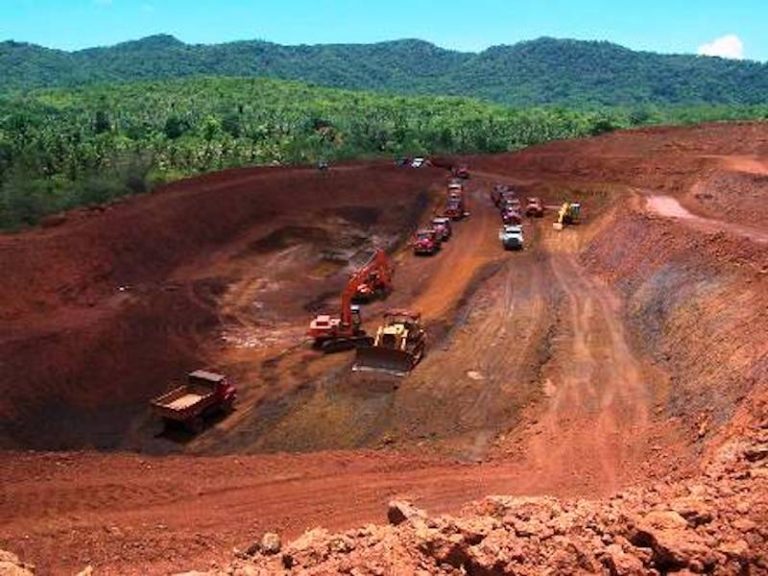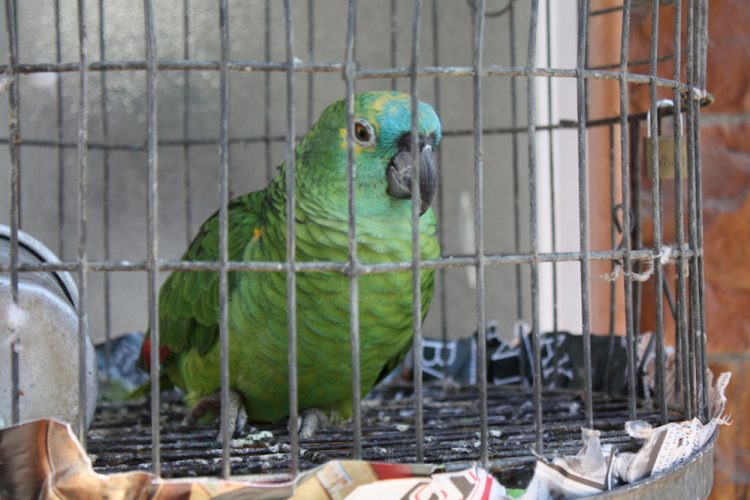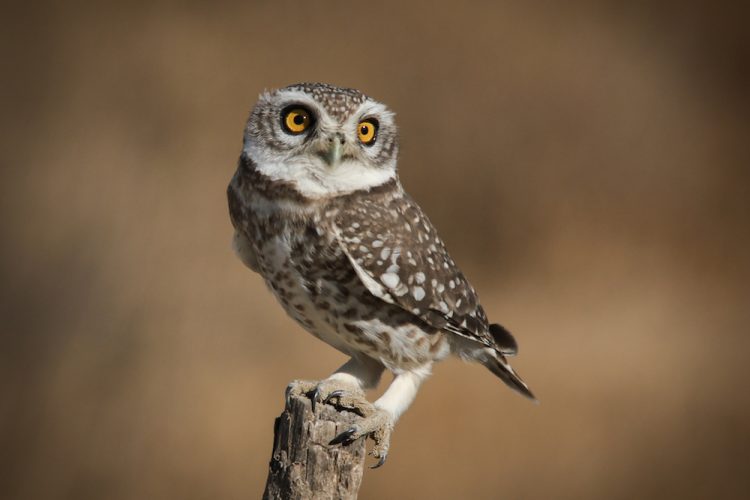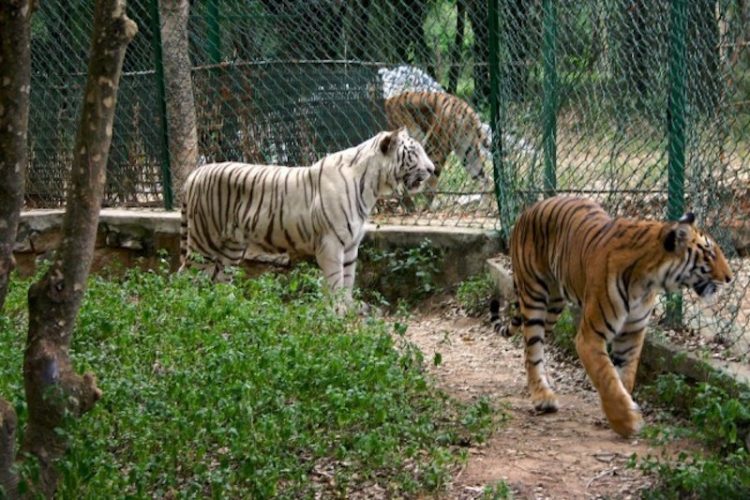7 Reasons Why Wildlife Is On The Decline Around Bengaluru
The kite was very patient. I was instructed to hold him gently, his wings and talons folded in a way that gave me control. The softness of his feathers under my fingers was soothing, but from his breathing I could tell he was ready to go. I stood in a gap between two rows of trees and threw him upwards into the air. He knew what to do immediately; with a few flaps he was above the trees. Soon, he was soaring.
A week ago, this black kite, a common bird of prey in and around Bengaluru, had come into the Bannerghatta Rehabilitation Centre (BRC) for rehabilitation after injury. He is one of the hundreds of wild animals treated by the BRC, an operation of the Wildlife Rescue and Rehabilitation Centre. The day I was there, the patients in this wild animal hospital included black kites, bonnet macaques, barn owls, rose-ringed parakeets, civet cats, common mynahs, spectacled cobras, and an Indian rock python. The reasons why they require treatment included abuse at the hands of their human neighbours, or owners and injuries due to human constructions and activities.

Animals are brought to the BRC by residents of all walks of life from Bengaluru and its environs, either in person or through a phone call that prompts the staff to use their meager resources to travel and pick up the poor affected individuals. Dr. Satish is encouraged that many different people from across Bengaluru have alerted the center to animals in distress. “I’m very proud of Bangaloreans. They come a long way for animals: rich, poor, kids.”
Once an animal arrives at the center, they undergo a thorough physical examination for physical injuries. They are provided resuscitation or rehydration fluids, deworming, and other medicines and vitamins. The aim is to release each animal to the wild as quickly as possible, after providing them enough time to heal. Highly social animals such as macaques are given a chance to socialize with others prior to being released in a group. Where possible, for example in cases where the macaques’ origins are known, the center attempts to release them back to their families. Through the whole process, staff maintain meticulous notes and records and maintain close communication with the Forest Department.
In 2013-2014 alone, the BRC treated 29 mammals, 230 birds and 38 reptiles, successfully releasing 186 of these. Of course not every animal that comes in survives; the injuries and illnesses of some are just too severe. What was blatantly clear to me, however, was the enormous passion, efforts and goodwill of Dr. Satish and Mr. Nair. These BRC staff provide each and every animal who enters the best care and love they could possibly receive.
“We’re living with a lot of urban wildlife, so become aware of it. There are lizards, chameleons, bats, birds, snakes. If you are aware, you can notice distressed animals and support them. These animals are helping us out.”
It is wonderful and remarkable that Bengaluru has such a center. It is sad, however, that a center like this needs to exist because that means wild animals are suffering. The reasons for this suffering are entirely due to human causes. Macaques had been electrocuted by live wires, parakeets had been abused at the hands of astrologers, cobras had become stuck in pipes at construction sites, owls had been beaten during acts of ‘black magic’, and birds had collided with the windows of glass buildings. Conflicts also arise between humans and wildlife as the city expands into previously wild areas and animals are faced with finding food and raising their families in a newly urbanized environment with a strange and often hostile new species of neighbour, that is, Homo sapiens.
From how we treat them directly to what we have done to their habitats – meaning the areas in which they seek shelter, find their natural foods and raise their young – our effects on wildlife are immense. Here are just a few of the acts of mischief that humans have been involved in and about which we can make changes as individuals and as a society.

1. Habitat destruction
This is one of the biggest threats to wildlife worldwide. As human activities such as urban development, road construction, industrial-scale agriculture and resource extraction encroach into wild areas, the amount of space available to the original inhabitants of those areas reduces. For example, a forest contains a wide diversity of species on the floor, among the bushes and at all levels of a forest canopy – meaning the various layers until the very tops of the tallest trees, with different species occupying different niche environments from the lowest areas of the tree trunks all the way to the highest branches. Imagine this complex multi-layered and multi-faceted universe being replaced by concrete and condominiums. Where are the animals to go? In some cases, the human residents of new subdivisions become frustrated at the entry of wildlife onto their property. But what we have to remember is that they are not invading our homes, rather they were there first and we moved into their territory.
2. Habitat fragmentation
Habitat fragmentation is closely related to habitat destruction. It is a term in conservation biology that means the breaking up of areas used by wildlife into smaller pieces that are surrounded by unsuitable areas. Wildlife’s need for continuous habitat can be understood If we think about our daily movements. We need a safe place to sleep and to raise families, access to healthy food and a safe travel corridor to get from home to our sources of food. What if our path from home to market were to be interrupted by a multi-lane highway? We would either risk our lives to get from one place to another, or starve. Human developments, if not planned responsibly and with an understanding of the habitats required by wildlife, can reduce wildlife areas to small, disconnected ‘islands’ that can’t support healthy populations.

3. Keeping wild animals as pets
Honestly, this is just a bad idea. Wild animals are exactly that. The average person cannot assume to understand the complexities of what a wild animal needs to lead a healthy life, and it is not in a wild animal’s nature to spend its days in the confines of a human abode, let alone a cage. A baby monkey can sure seem cute – like a little cousin with opposable thumbs, a prehensile tail and an adorable faux-hawk. But do we ever see a lone monkey in the wild? They live in groups. Many people have taken home a young male monkey only to realize that as he gets older and mature, he misses his natural ways and surroundings and begins to become aggressive. Suddenly he is not so cute and becomes a hazard. His owners are then forced to make a decision about what to do with him.

4. Abusing animals or taking advantage of abused animals
The animals we see in cages on the street, whose owners offer us astrological and other services, are obviously not there by choice. Rose-ringed parakeets are often stolen as babies from their nests and are trained to pull cards or perform other tricks ostensibly as fortune tellers. These same birds may be abused by their owners to keep them in submission. Their wings are clipped so they cannot fly away.
There are also some among us who believe that doing injury to an animal can translate into a similar injury to a person with whom we are in conflict. It may be hard to believe that this practice exists in Bengaluru, but the BRC receives otherwise unexplainable cases of injury to owls and slender loris, which are known to be abused in this manner and for this reason.

5. Feeding wild animals
Isn’t this the opposite of abusing animals? Why is it bad? Unfortunately, most of us don’t know how to give a wild animal a balanced and appropriate diet. Imagine if we entrusted a crow to determine our dietary requirements, and then began to feel dependent on that crow to keep feeding us. Not only would we be eating some nasty stuff, but we would start to pester that crow to give us more and better. Okay, that’s a bit of a stretch, but it is not uncommon to see tourists feeding junk food to wild animals. It’s not good for us, to begin with, and not good for them either, from a dietary perspective. It also trains them to associate humans with food, meaning they are more likely to approach people and enter homes to look for it, demand it or simply take it.
6. Direct conflict, injury, and poison
Most of us are peace-loving but some people, when frustrated at animals stealing from their gardens or kitchens, or frightened by the presence of snakes or other creatures we don’t know how to handle, can turn to violence or poison. Poisoning may kill the intended rat, but it will also kill any other animal that may encounter and eat the poison. Furthermore, even after killing a rat it will proceed to poison any animal that subsequently eats that rat, for example a snake or a bird, then poison any animal that eats that snake or bird, and so on. In other words, the poison does not end at the rat; it travels throughout the food web. Similarly, many pesticides kill both wanted and unwanted insects alike, and again can affect the food web. Remember that pesticides are bad for human health too. Just as there is always an alternative to violence against another human being, there are other ways to deal with these situations which I will address below.
7. Physical hazards
From construction sites to live wires to tall buildings to open pipes, humans provide an endless array of traps and pitfalls for wild animals who are unfamiliar with our habits and technologies. A general lack of understanding of what to do if a wild animal, injured or healthy, is found at one of these sites can cause anxiety among the people involved and exacerbate the problem.
It is easy to fall into despair when we begin to brainstorm these issues, and it can seem impossible to figure out how to address them. As a conservation biologist, I spend most of my days thinking not only about the problems humans cause for wildlife but also the solutions. These solutions are in the choices we make and the actions we take, both big and small.
What you can do
There is something for everyone to do to contribute to the world where humans and wild animals can co-exist. We cannot underestimate the power of setting a positive example for others through our own actions. And when many people take small positive actions and come together, a movement is formed and society can change for the better. Here are a few ideas for actions that each of us can take.
- Support the protection of forests, wetlands and other areas. With more natural habitat available to them, wild animals are less likely to need to come into urban areas looking for food. Not only are natural areas homes for these animals, they also provide a plethora of benefits to humans as sources of oxygen production, carbon sequestration, medicines, biodiversity, mental health and aesthetic beauty.
- Support the reforestation of areas that have been damaged or altered, through revitalization with a diversity of native species of trees and other plants, including those that provide food for wildlife.
- Make any glass faces on your buildings obvious as hard surfaces to birds, so that they don’t fly into them. Easy ways to do this are to install some kind of pattern on your window face or a fine mesh screen. The latter will help keep out mosquitoes too! Or get the kids involved with some window paint markers and have them draw some pretty designs.
- Plant native trees and shrubs on your property to help create urban oases for birds. According to Dr. Satish, birds such as bee-eaters can eat thousands of mosquitoes over the course of one day. Planting native shrubs in pots on your balcony could attract butterflies which are beautiful and important for biodiversity and the food web. They can also attract pollinators such as bees; without pollinators, we would suffer food shortages.
- Don’t use astrologers who use animals as part of their practice. Discourage others from using them as well. You can even publicly speak out against people who you know steal or abuse wild animals, to show them that what they are doing is not acceptable. Alternatively, you can obtain the details of the individuals and report them to the police.
- Avoid using poisons such as rat poison or pesticides. You can address the root cause of your rat problem by rat-proofing your home, ensuring the area around your home is free of garbage and welcoming pest predators such as rat snakes.
- Support conservation organizations who are educated about and working on habitat protection and restoration, either by donating funds or time as a volunteer. Many of these organizations rely heavily on donations of time and money from people like yourselves.
- Elect public officials who want to preserve natural areas. Inform your elected officials and electoral candidates that wildlife and habitat protection are priorities for you.
- Educate each other about wildlife conservation issues, be conscious of the effects of your actions on wildlife and promote respect for nature.
- Educate each other about basic respect for human beings and speak out against the practice of intending to harm humans by harming wild animals.
- Invite the Wildlife Rescue and Rehabilitation Centre to come give a talk in your building, workplace, community center or school.
In the meantime, the Bannerghatta Rescue Centre is active and its staff enthusiastic. “We’re living with a lot of urban wildlife,” says Dr. Satish, “so become aware of it. There are lizards, chameleons, bats, birds, snakes… If you are aware, you can notice distressed animals and support them. These animals are helping us out.”
The centre is a small operation with a big impact. It needs consistent funds for physical and health care equipment, fuel for animal transport and the particular dietary requirements of the animals that come under its care. The centre also accepts interns and committed volunteers to help with specific tasks such as fundraising and maintenance. You can learn more about the centre and its parent organization, the Wildlife Rescue and Rehabilitation Centre, at their website: The website also contains information about making donations and getting involved as a volunteer.
What to do if you find an animal in distress
There could come a day when you come across a sick or injured an animal in Bengaluru – what do you do?
First, determine if it is a domestic animal like a dog or a cat. In the case of a domestic animal, you can contact Charlie’s Animal Rescue Centre (CARE) near Jakkur at 09483911110.
If it is a wild animal (including birds, primates, and reptiles), then you can phone the Wildlife Rescue and Rehabilitation Centre immediately for guidance on what to do: 09901510394, 08022947307 or 08022947317. For example if you find a small injured bird, you can administer first aid by delicately placing it in a cardboard box with a towel and air holes, making notes about where and when you found it, and in what condition, keeping it in a quiet place and calling the centre. The sooner you phone them the better, because the sooner the animal can receive care the more likely it is to survive. For help, get in touch with the Avian and Reptile Rehabilitation Trust at 9620286800.
“Spread the word,” says Dr. Satish. The more people learn about and act on these issues the fewer animals will need to be rescued.
Content credit https://thelogicalindian.com/story-feed/awareness/bengaluru-wildlife/
